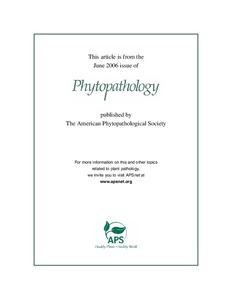| dc.contributor.author | Bandyopadhyay, Ranajit |
| dc.contributor.author | Mwangi, M. |
| dc.contributor.author | Aigbe, S.O. |
| dc.contributor.author | Leslie, John F. |
| dc.date.accessioned | 2019-12-04T11:18:05Z |
| dc.date.available | 2019-12-04T11:18:05Z |
| dc.date.issued | 2006 |
| dc.identifier.citation | Bandyopadhyay, R., Mwangi, M., Aigbe, S.O. & Leslie, J.F. (2006). Fusarium species from the cassava root rot complex in West Africa. Phytopathology, 96(6), 673-676. |
| dc.identifier.uri | https://hdl.handle.net/20.500.12478/3031 |
| dc.description.abstract | Fusarium species are a significant component of the set of fungi associated with cassava root rot. Yield losses due to root rot average 0.5 to 1 ton/ha but losses >3 ton/ha, an equivalent of 15 to 20% yield, often occur. This paper reviews previous work on cassava root rot and summarizes a few recent studies on Fusarium species associated with the disease. Our studies in Cameroon showed that 30% of rotted tubers were infected by Fusarium spp. 12 months after planting and represented 25% of all the fungal isolates recovered. Other commonly recovered fungi were Botryodiplodia theobromae and Armillaria spp. Numerous and diverse species of Fusarium were associated with rotted cassava roots in Nigeria and Cameroon. At least 13 distinct amplified fragment length polymorphism (AFLP) groups of Fusarium were distinguishable, each group probably a distinct species, and many of them might represent previously undescribed Fusarium species. The two largest of the AFLP groups correspond to F. oxysporum and F. solani species complex. The distribution of Fusarium spp. varied among countries and among locations within a country, suggesting that germ plasm resistant at one location may not be resistant at another. Fusarium spp. also cause seedling blight of cassava and can be recovered from the stems of infected plants up to 1 m above the ground. Therefore, the pathogen can spread with stems cut as planting material. Fusarium spp. also can colonize Chromolaena odorata, the dominant weed in short fallows, which could further complicate management efforts by serving as an alternative host for strains that colonize cassava. |
| dc.language.iso | en |
| dc.subject | Fusarium Species |
| dc.subject | Cassava Root Rot |
| dc.subject | Tuberous Roots |
| dc.subject | Pathogens |
| dc.subject | Trichoderma Species |
| dc.subject | Armillaria Species |
| dc.title | Fusarium species from the cassava root rot complex in West Africa |
| dc.type | Journal Article |
| dc.description.version | Peer Review |
| cg.contributor.affiliation | International Institute of Tropical Agriculture |
| cg.contributor.affiliation | Kansas State University |
| cg.coverage.region | Africa |
| cg.coverage.region | Acp |
| cg.coverage.region | West Africa |
| cg.coverage.region | North America |
| cg.coverage.country | Nigeria |
| cg.coverage.country | United States |
| cg.isijournal | ISI Journal |
| cg.authorship.types | CGIAR and advanced research institute |
| cg.iitasubject | Disease Control |
| cg.iitasubject | Farm Management |
| cg.iitasubject | Food Security |
| cg.iitasubject | Plant Breeding |
| cg.iitasubject | Plant Genetic Resources |
| cg.iitasubject | Agribusiness |
| cg.iitasubject | Plant Production |
| cg.iitasubject | Pests Of Plants |
| cg.iitasubject | Cassava |
| cg.iitasubject | Plant Diseases |
| cg.iitasubject | Handling, Transport, Storage And Protection Of Agricultural Products |
| cg.accessibilitystatus | Limited Access |
| local.dspaceid | 94497 |

